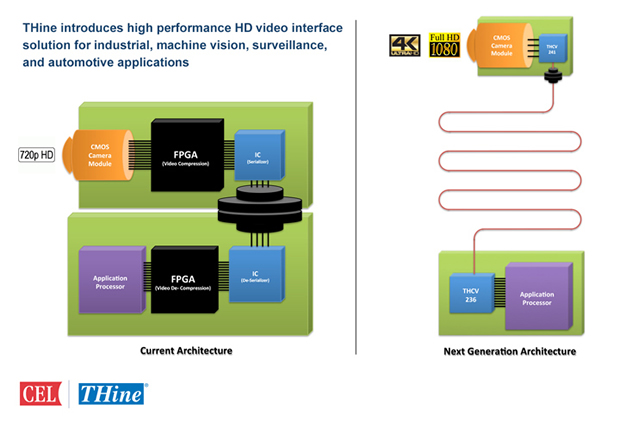Designers create vision systems with fewer cables
A semiconductor company focusing on high speed serial interfaces, THine, has announced an AEC-Q100 (Grade 2) compliant single chip solution (THCV241-Q) that integrates the MIPI CSI-2 interface with THine’s well established V-by-One HS product family.
Because today’s high resolution CMOS camera modules mainly use the MIPI CSI-2 protocol output for its high data rate, transmission distance is limited to about 30cm. However, MIPI CSI-2 integrated in the THCV241-Q processor chip extends cable length to 15m for uncompressed 1080p60 video data via a shielded twisted pair or a single coaxial line. In cars, for example, a clear rear view image is available to any point inside the vehicle without compression-induced latency. High Dynamic Range image displays in vehicles achieve unparalleled clarity.
THine also offers various receiver chips that support 150MHz parallel output and Open LDI (LVDS) output for 2 Mega-Pixel images or 1080p60 and plans to develop more line-ups. In addition, because the THCV241-Q processor supports transmission through a Slip-ring, PTZ cameras do not need close proximity to the Application Processor. The THCV241-Q’s outstanding video transmission performance also reduces costs and camera system size restrictions. For example, compared with Open LDI (LVDS) transmission, THCV241-Q transmission requires only one-fourth as many expensive slip ring cores, for a 75% cost reduction in the internal interfaces of PTZ cameras.

“We are excited to release our MIPI interface products worldwide,” said Kazutaka Nogami, CEO of THine. “By working with hundreds of real world designs, we have refined our video processing and networking technologies. Combining MIPI and V-by-One HS enables design engineers create affordable, high performance next generation camera and industrial vision designs.”
“Ease of design is critical for fast time to market,” added Paul Minton, President and CEO of CEL. “CEL’s decades of supporting leading edge designs matched to THine’s advanced technology will enable designers to execute camera designs faster than before at lower cost, smaller size and higher performance.”
Samples are scheduled for release in December 2016. To speed time to market and reduce design expense, THCV241-Q design support will include Evaluation Boards, application notes, datasheets, etc. CEL and THine have established design support in North America as well as Japan and the rest of Asia.





